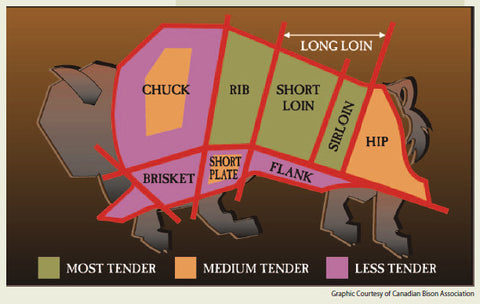Know Your Buffalo Cuts
Bison Meat Cuts: A Guide to Tenderness and Location
The majestic bison, once a critical component of North American ecosystems and indigenous communities, is not only valued for its historical significance but also for its delicious and nutritious meat. Unlike typical beef, bison meat is leaner, richer in protein, and has a slightly sweeter taste. But, just like cattle, different cuts of bison meat have varied flavors and tenderness, depending on their location. Let’s delve into the various cuts, where they're located, and their tenderness level.
1. Chuck: Located at the front of the animal, the chuck comprises the shoulder and neck region. This part is frequently used for ground meat, roasts, and stew meat due to its relatively tougher nature. Long, slow cooking methods are ideal for tenderizing this cut.
2. Rib: Located just behind the chuck, the rib section offers some of the most sought-after cuts. This is where the prime rib and ribeye steaks come from. They are known for their marbling, flavor, and tenderness when properly cooked.
3. Brisket: Found in the lower chest or breast area, the brisket is a rather tough cut due to the collagen and connective tissues. It's a favorite for barbecuing and smoking, and when cooked low and slow, it can become incredibly tender and flavorful.
4. Plate and Flank: These are situated below the rib and are relatively tougher parts of the bison. The plate is the source of skirt steaks, while the flank is where flank steaks come from. Both cuts are lean and benefit from marination and quick, high-heat cooking methods.
5. Short Loin: Positioned towards the back, behind the ribs, the short loin is home to some of the tenderest cuts, including the T-bone and tenderloin steaks. These cuts are perfect for grilling due to their inherent tenderness.
6. Sirloin: Situated just behind the short loin, the sirloin is slightly less tender than the loin cuts but still offers a rich flavor. Sirloin steaks and roasts are versatile and can be grilled, broiled, or pan-seared.
7. Round: This is the rear end of the bison, comprising the buttock and upper leg. Although lean and less tender than cuts like the ribeye or T-bone, the round is excellent for roasts, ground meat, and stew. Slow cooking and braising are ideal for these cuts.
8. Shank: Located in the legs, the shank is a very tough cut due to the heavy muscles and connective tissues. It's perfect for dishes that require long cooking times like broths and stews, where it can become tender and impart a rich flavor.
In summary, the tenderness of bison cuts largely depends on the amount of work each muscle does during the animal’s life. Muscles that work harder, such as those in the chuck and shank, are tougher, while lesser-used muscles, like in the short loin, are more tender. Regardless of the cut, bison meat offers a unique and delightful culinary experience, especially when prepared with care and understanding of each cut's characteristics.


